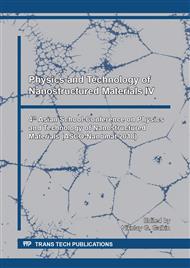[1]
K. Nakada, M. Fujita, G. Dresselhaus, M.S. Dresselhaus, Edge state in graphene ribbons: nanometer size effect and edge shape dependence, Phys. Rev. B. 54 (1996) 17954-17961.
DOI: 10.1103/physrevb.54.17954
Google Scholar
[2]
Y. Kobayashi, K. Fukui, T. Enoki, K. Kusakabe, Y. Kaburagi, Observation of zigzag and armchair edges of graphite using STM and STS, Phys. Rev. B. 71 (2005) 193406.
DOI: 10.1103/physrevb.71.193406
Google Scholar
[3]
A.M. Ziatdinov, Nanographites, their compounds, and film structures, Russ. Chem. Bull. 64 (2015) 1-14.
DOI: 10.1007/s11172-015-0812-y
Google Scholar
[4]
A.M. Ziatdinov, N.S. Saenko, P.G. Skrylnik, Molecular and electronic structure and magnetic properties of multilayer graphene nanoclusters and their changes under the influence of adsorbed molecules, Russ. Chem. Bull. 66 (2017) 837-848.
DOI: 10.1007/s11172-017-1816-6
Google Scholar
[5]
A.M. Ziatdinov, P.G. Skrylnik, N.S. Saenko, The influence of an adsorbate and edge covalent bonds on topological zero modes in few-layer nanographenes, Phys. Chem. Chem. Phys. 19 (2017) 26957-26968.
DOI: 10.1039/c7cp03423g
Google Scholar
[6]
Yu.M. Nikolenko, A.M. Ziatdinov, Synthesis and characterization of nanographites with chemically modified edges, Russ. J. Inorg. Chem. 57 (2012) 1436-1442.
DOI: 10.1134/s0036023612110101
Google Scholar
[7]
R. Taira, A. Yamanaka, S. Okada, Electronic structure and electric polarity of edge-functionalized graphene nanoribbons, Jpn. J. Appl. Phys. 56 (2017) 085103.
DOI: 10.7567/jjap.56.085103
Google Scholar
[8]
G. Magda, X. Jin, I. Hagymaґsi, P. Vancsoґ, Z. Osvaґth, P. Nemes-Incze, Room-temperature magnetic order on zigzag edges of narrow graphene nanoribbons, Nature. 514 (2014) 608-611.
DOI: 10.1038/nature13831
Google Scholar
[9]
K. Sasaki, J. Jiang, R. Saito, S. Onari, Y. Tanaka, Theory of superconductivity of carbon nanotubes and graphene, J. Phys. Soc. Jpn. 76 (2007) 033702.
DOI: 10.1143/jpsj.76.033702
Google Scholar
[10]
A. Kinikar, T.P. Sai, S. Bhattacharyya, A. Agarwala, T. Biswas, S.K. Sarker, Quantized edge modes in atomic-scale point contacts in graphene, Nature Nanotechnol. 12 (2017) 564-568.
DOI: 10.1038/nnano.2017.24
Google Scholar
[11]
W.S. Hummers Jr., R.E. Offeman, Preparation of graphitic oxide, J. Amer. Chem. Soc. 80 (1958) 1339-1339.
DOI: 10.1021/ja01539a017
Google Scholar
[12]
A.M. Ziatdinov, Y.V. Zelenskii, A.A. Uminskii, E.G. Ippolitov, Synthesis and investigation of intercalated oxygen-containing graphite compounds, Zhurnal Neorganicheskoi Khimii. 30 (1985) 1658-1664.
Google Scholar
[13]
N. Iwashita, C.R. Park, H. Fujimoto, M. Shiraishi, M. Inagaki, Specification for a standard procedure of X-ray diffraction measurements on carbon materials, Carbon. 42 (2004) 701-714.
DOI: 10.1016/j.carbon.2004.02.008
Google Scholar
[14]
L.G. Cancado, A. Jorio, M.A. Pimenta, Measuring the absolute Raman cross section of nanographites, Phys. Rev. B. 76 (2007) 064304.
DOI: 10.1103/physrevb.76.064304
Google Scholar
[15]
A.C. Ferrari, J. Robertson, Interpretation of Raman spectra of disordered and amorphous carbon, Phys. Rev. B. 61 (2000) 14095-14107.
DOI: 10.1103/physrevb.61.14095
Google Scholar
[16]
A.M. Ziatdinov, N.M. Mishchenko, Yu.M. Nikolenko, Phase transition and incommensurate states in GIC C5nHNO3, Synth. Met. 59 (1993) 253-258.
DOI: 10.1016/0379-6779(93)91034-y
Google Scholar
[17]
A.M. Ziatdinov, N.M. Mishchenko, Phase transitions and nonmetallic, temperature dependence of conduction electron spin resonance line width in quasi-two-dimensional synthetic metal C15HNO3, Solid State Commun. 97 (1996) 1085-1089.
DOI: 10.1016/0038-1098(95)00702-4
Google Scholar
[18]
M. Ziatdinov, S. Fujii, M. Kiguchi, T. Enoki, S. Jesse, S.V. Kalinin, Data mining graphene: correlative analysis of structure and electronic degrees of freedom in graphenic monolayers with defects, Nanotechnology. 27 (2016) 495703.
DOI: 10.1088/0957-4484/27/49/495703
Google Scholar


